20 things to know when raising chickens for dinner
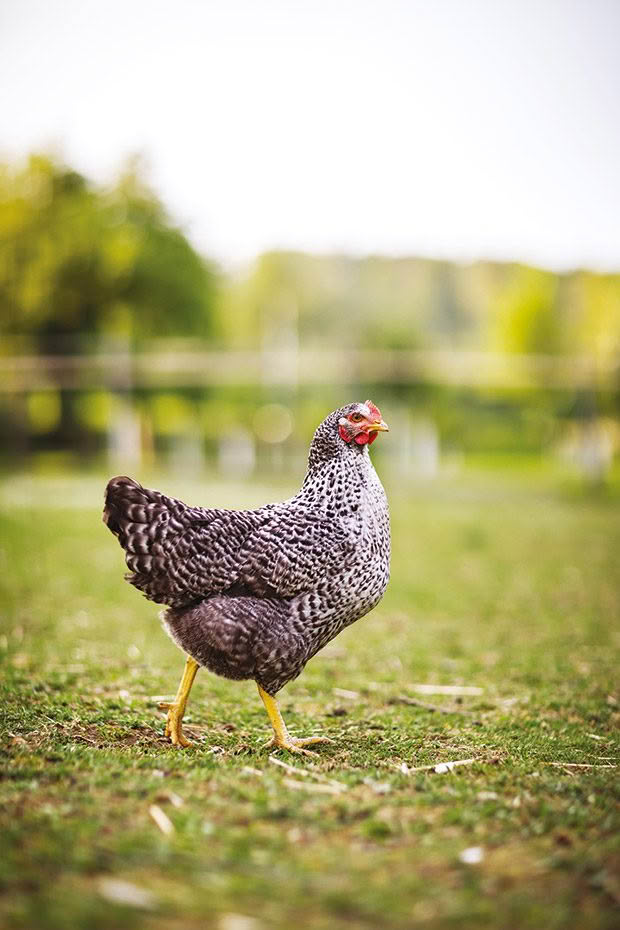
Here’s how to grow a good-sized dinner and process it safely.
Words: Nadene Hall
If you want to eat amazingly cheap meat, you won’t beat the cost of supermarket chicken. More than 127 million birds are plucked, processed, bagged, and stuffed for sale, with options from whole, free-range, organic chicken ($15-$24) to whole, barn-raised birds for $8-$12, depending on weight. So is it a good idea (and economical) to raise spare cockerels or dedicated meat birds instead of buying meat from the supermarket? Possibly.
THE COSTS
It’s difficult to account for your time, heating costs, buying/breeding, and raising chicks. Feed is your biggest cost, especially if you choose to use organic products.
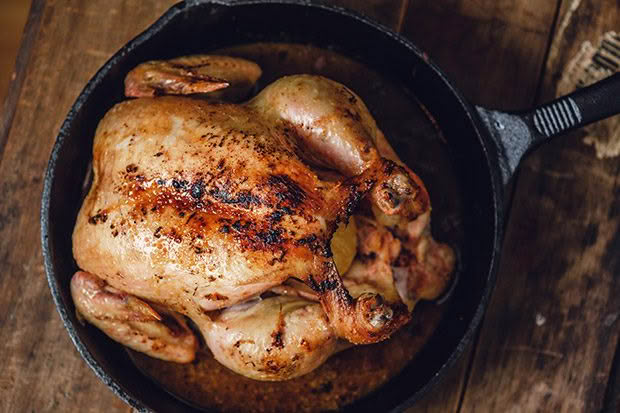
It takes 1.5kg of quality, balanced feed for a commercial hybrid broiler (Cobb, Ross) to produce 1kg of meat in perfect commercial conditions. A crossbred bird with good attributes living in backyard conditions will need about 2-3kg of feed and take weeks longer to achieve a similar result.
A 2020 analysis of the costs found:
Lifetime feed costs: $8.50-$22 per bird (depending on breed, cost of different feeds)
Time: 10 weeks (commercial broiler hybrid) – 25 weeks (crossbred heavy breed)
Overall cost per bird: $10-$25
Non-economic reasons to raise your own roasts:
• No waste of the time/feed raising cockerels to the age where you can sex them — on average, they’ll make up 50% of any eggs you hatch.
• You know exactly where your bird came from, how it lived, and what medications it had (if any);
• You can make sure it’s humanely killed and processed.
ADVANTAGES OF HYBRID MEAT BIRD
The conversion of feed to meat is important. Hybrid broilers grow almost twice as fast, on less feed than the average crossbreed. Fed and managed well, they’ll reach 3kg+ in 5-6 weeks, and 4kg in just 10 weeks. Hybrid meat chicks are available to buy from hatcheries and on Trade Me.
WHAT MAKES A GOOD MEATY BIRD?
The best birds for roasting have:
– a father with a big broad breast;
– a plump mother;
– a strong, sturdy build to carry maximum muscle on breast and legs;
– a fast growth rate from day one.
Good meaty purebreds include:
– Plymouth Rocks;
– Orpingtons;
– Dorkings.
The traditional meat bird of choice in the 19th century was a cross between a Rhode Island Red rooster and a Light Sussex hen. If the parents are purebred, the colouring of the chicks’ down will tell you the sex of the chicks when they hatch.
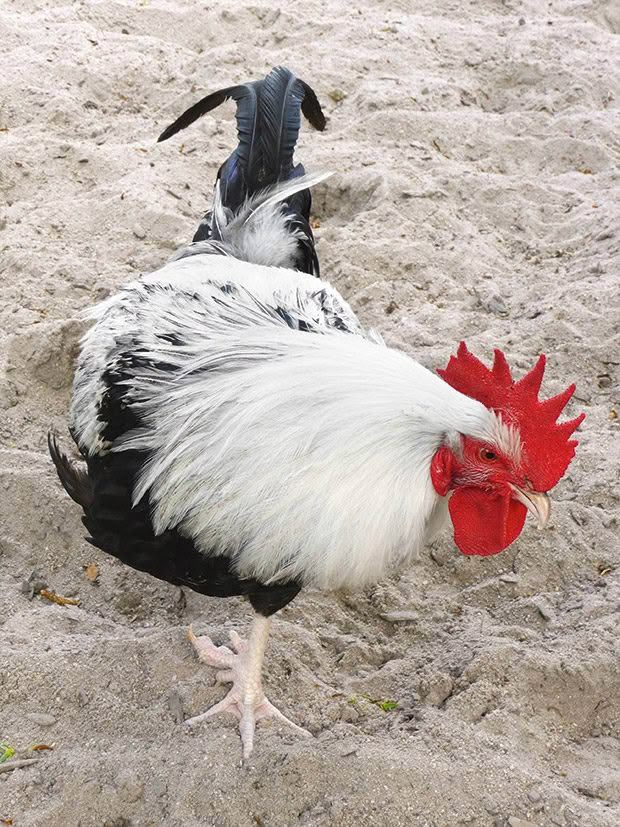
Dorking rooster. Photo: 3268zauber / Wikimedia Commons.
Females hatch with golden brown down (like their dad). Males hatch with yellow down. This is useful if you want to raise the roosters for meat because you can get them straight onto a meat crumble diet.
Why feather colour might affect your choice of bird
Most people have only ever seen the white-pink skin of the raw poultry they buy at the supermarket. That’s because the hybrid birds grown on commercial meat farms have white feathers. When you pluck a chicken, the follicles release a pigment the same colour as the feather. You don’t notice the clear-white liquid on a white-feathered bird, but the black pigment stands out on the pale skin of black-feathered birds.
The pigment doesn’t affect the meat or how it tastes, and it disappears when the meat is cooked. Some breeds have naturally yellow skin, and clear-yellow pigment.
KEEP THEM IN THEIR OWN COOP
Meat birds need a run and coop separate to layer hens. You don’t want layers eating meat crumbles or meat birds eating layer feed. It also reduces the risk of disease.
The minimum space for six birds is a three square metre run (3m x 1m), but you may want to give them more space. A moveable ark with a warm, rain-proof shelter is a good option. They must have feed and water available at all times.
Feed them the right diet
From hatching, chicks need 24-hour access to:
– a brooder, until old enough to go outside;
– a high-quality meat crumble;
– fresh, clean water in a shallow dish.
If you can identify females and you want to keep them as layers, separate them from the boys and feed them chick starter. However, if you want to eat everyone, feed them all on meat crumbles from the day they hatch.
KEEP THEM WARM & LAZY
Chicks can’t control their body temperature for the first couple of weeks of life. They need a constant heat source such as a heat lamp, or they’ll use the energy they get from feed to keep warm instead of growing muscles and bone. They also grow faster if you restrict the area they can roam, so they don’t use too much energy running around.
The best feed for fast growth
If you’re choosing to grow birds as fast as possible, feed them only meat crumbles until you’re ready to process them. These are high in protein and energy and contain the correct vitamins and minerals birds need for good health and growth.
Feeding extra greens or scraps may work against you if birds fill up on forage and don’t eat enough crumbles to support good growth. Forage and other extras don’t save you money; the birds just take longer to grow, and the feed costs will be similar.
The best feed for flavour
Birds eating greens (along with their main diet of meat crumble) and moving around a free range will produce a stronger flavoured meat, and it may be a darker colour than supermarket chicken, as both affect cartilage growth.
Kill them at the right time
It’s entirely your choice on the right time to process a bird. Practically, it’s best to sacrifice a little bit of weight and do it before they start fighting and crowing, anytime from 16-20 weeks. However, you can keep them for up to a year if you want a gamier taste in the meat.
Weight is another useful measure. A dressed (plucked, processed) bird will weigh approximately two-thirds of its liveweight:
• a 3kg bird will dress out at around 2kg;
• a 4kg bird will dress out at around 2.7kg.
6 WAYS TO KEEP THE BOYS QUIET
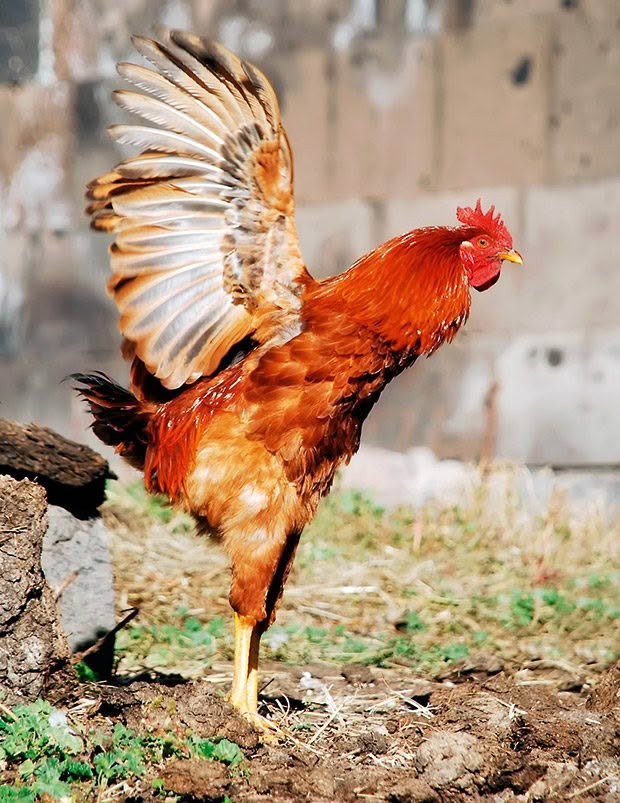
It makes practical sense to keep roosters for meat in one pen, but it can pose a problem if they start fighting when testosterone kicks in.
• Try to group roosters of the same age, colour, and size.
• Keep them out of sight of your hens and main breeding rooster/roosters.
• Look out for bullying of smaller roosters or injuries, and quickly remove the affected bird to a separate area.
• Always have feed and water available in lots of troughs over a wide area so birds can avoid each other where possible.
• Have a variety of different shelters and perching areas so they can spread out. Place cardboard boxes and/or plant tall grasses so they can move out of each other’s sight.
• In their last week or two, give them something to do such as pecking blocks – hang cabbages at rooster head height, and/or cut up pieces of pumpkin and scatter them throughout the run. Distractions help them to use up energy and focus on something other than fighting.
PRO TIP
You can grow hybrid meat birds more slowly to get a more flavourful meat, although it will cost more than feeding only meat crumbles. To grow hybrid meat birds slowly, feed:
• chick starter* from weeks 0-4;
• grower feed from weeks 4-9;
• meat crumbles from week 10 onwards.
Chick starter contains a coccidiostat that has a withholding period for eggs and meat. Birds should be fed meat crumbles for at least the last 7 days of their lives. Broilers kept indoors in a warm area for their whole lives will have tender flesh and a mild flavour compared to birds allowed to free-range and forage.
A BUTCHER’S CHICKEN PROCESSING SET-UP
Ross Nolly sets up outdoors when he processes his meat birds. It takes about 10 minutes from the time he humanely kills a bird to putting its clean, processed carcass in a sealed bag in the fridge.
Cleanliness is vital. Ross buys a small plastic tarpaulin to use every time he butchers birds (which he washes and re-uses, but not for butchering). There are a couple of buckets of soapy water for washing his hands and knife, and one that he uses to wash down the table in between birds.
The white 20-litre bucket to the right of the table is for scalding the birds. Ross adds boiling water to it to maintain the temperature (55°C-75°C). The red bucket on the far right is full of soapy water for handwashing during plucking (which is done just to the right of the table). A freshly-killed carcass is hung by the feet on the washing line, a few metres away.
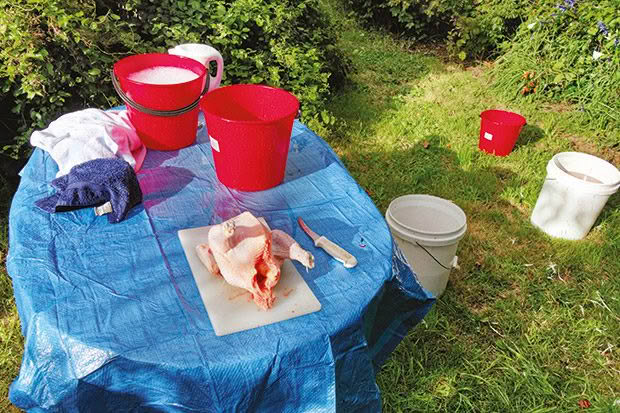
“I put a large flexi-bin under the bird. That way, the feathers drop straight into it. When I’ve finished plucking, I also give the hanging bird a blast with the hose to wash off any feathers that have stuck to the carcass so I can see if I’ve missed any.”
Every time he needs to touch something new, Ross washes his hands. He guts birds on the edge of the table and the organs fall into a bucket at his feet, helping to keep the table clean. He has a separate bucket for livers and hearts which he uses for pet food. Once a bird is processed, it’s rinsed off in cold water and put in a sink of icy water.
Ross vacuum-seals birds in bags for freezing using a ‘redneck water bath’.
YOU’LL NEED:
kettle
thermometer (with a long probe)
cutting board
sharp poultry boning knife
scissors
hose
easy-to-clean work surface,
eg plastic table, stainless steel bench, plastic tarpaulin
4 x 20-litre food grade buckets
2 x smaller buckets of soapy water
1 smaller bucket of clean water
2 x towels
WHO CAN EAT HOMEKILLED MEAT?
Homekill can be eaten by:
– the animal owner;
– the direct family or household of the animal owner;
– farmworkers employed in a farm’s daily operations;
– the farmworkers’ families and households.
It’s illegal to:
– sell homekilled meat;
– serve homekill meat to paying customers (for example, to guests at bed and breakfasts or lodges);
– trade or barter homekill meat;
– raffle or donate the meat for use as a prize or as a fundraiser.
Can you sell meat birds you’ve processed yourself?
No. Poultry meat comes under the Food Safety Act and is classed similarly to red meat in regard to resale. It must be slaughtered and processed in licensed premises for resale to the public in a shop or farmers’ markets. It can be difficult and expensive to do this legally.
Love this story? Subscribe now!
 This article first appeared in NZ Lifestyle Block Magazine.
This article first appeared in NZ Lifestyle Block Magazine.
